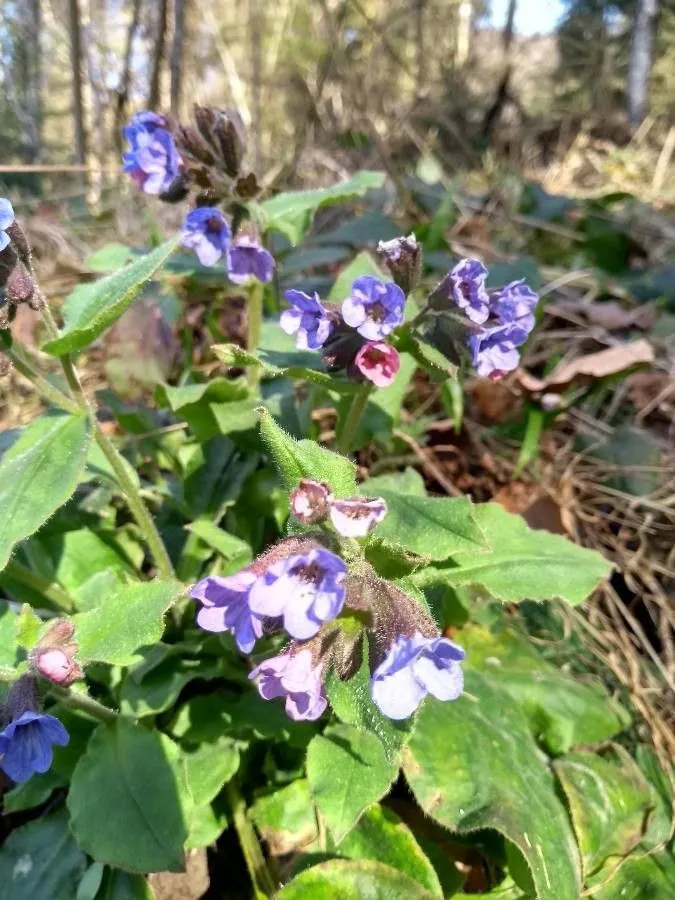
Author: Dumort.
Bibliography: Bull. Soc. Roy. Bot. Belgique 4: 341 (1865)
Year: 1865
Status: accepted
Rank: species
Genus: Pulmonaria
Vegetable: False
Observations: Europe to W. Siberia
Suffolk lungwort, known scientifically as Pulmonaria obscura, is a captivating and resilient flowering plant that belongs to the Boraginaceae family. This species was first described in 1865 by the esteemed botanist Dumort, as documented in the Bulletin de la Société Royale de Botanique de Belgique. The plant is indigenous to a vast expanse stretching from Europe to Western Siberia.
Pulmonaria obscura is especially valued in botanical and horticultural circles for its unique aesthetic and ecological properties. As one of the early bloomers in the understorey of temperate forests, it adds a splash of color with its delicate blossoms, often appearing when the canopy trees have yet to fully leaf out. The foliage is also quite distinctive, typically featuring broad, ovate leaves that can sometimes be spotted with white or silver, creating a striking variegation that provides visual interest throughout the growing season.
In terms of habitat, Suffolk lungwort thrives in moist, shaded woodlands and meadows, adapting well to the filtered light and rich, humus-laden soil found in these environments. This adaptability has allowed it to extend its range across a diverse climatic zone, from the temperate regions of Europe to the harsher, colder climates found in parts of Western Siberia.
Beyond its ornamental appeal, Suffolk lungwort has historical significance as well. The genus name “Pulmonaria” is derived from the Latin word “pulmo,” meaning lung. This nomenclature reflects the plant’s historical use in traditional medicine, where it was believed the leaves could be used to treat respiratory conditions due to their lung-like appearance, in alignment with the Doctrine of Signatures.
Cultivation of Pulmonaria obscura in garden settings is relatively straightforward, particularly when mimicking its natural woodland habitat. It prefers partial to full shade and requires well-drained but consistently moist soil. Gardeners prize it for its low maintenance and its ability to form attractive ground cover, which can suppress weeds and enhance the biodiversity of garden ecosystems by providing habitat and nectar for various pollinators, including bees and butterflies.
The Suffolk lungwort thus offers both beauty and utility, making it a cherished component of both natural and cultivated landscapes across its native range. It stands as a testament to the synergistic relationship between plants and the environments they inhabit, illustrating the rich botanical diversity that characterizes much of the northern hemisphere.
Fin: (lehto)imikkä
Swe: (lehto)imikkä, lungört, mörk lungört, vanlig lungört
Dan: almindelig lungeurt
Deu: dunkles lungenkraut, ungeflecktes lungenkraut
Eng: suffolk lungwort, unspotted lungwort
Nld: ongevlekt longkruid
Nob: mørklungeurt
Nno: mørklungeurt
Cym: llysiau’r-ysgyfaint difrychau
En: Suffolk lungwort, Unspotted lungwort
Ba: Биҫтау үләне
Be: Медуніца няясная
Bg: Тъмна медуница
Cs: Plicník tmavý
Da: Almindelig Lungeurt
Nl: Ongevlekt longkruid
Et: Harilik kopsurohi
Fi: Imikkä, Lehtoimikkä, (lehto)imikkä
Fr: Pulmonaire sombre, Pulmonaire à fleurs sombres, Herbe aux poumons, Herbe de coeur, Pulmonaire d’Italie
De: Dunkles Lungenkraut, Ungeflecktes Lungenkraut, Dunkelgrünes Lungenkraut
It: Polmonaria scura
Lt: Tamsioji plautė
Nb: Mørklungeurt
Nn: Mørklungeurt
Os: Цъæх цъироба
Pl: Miodunka ćma
Ru: Медуница неясная
Sk: Pľúcnik tmavý
Sv: Lungört, (lehto)imikkä, Mörk lungört, Vanlig lungört
Uk: Медунка темна
Cy: Llysiau`r-ysgyfaint difrychau, Llysiau’r-Ysgyfaint Difrychau
Taken Apr 18, 2018 by tep (cc-by-sa)
Taken Mar 20, 2020 by Martin Martin (cc-by-sa)
Taken Mar 28, 2020 by Martin Martin (cc-by-sa)
Taken Jun 6, 2021 by sara.moreira (cc-by-sa)
Taken Apr 3, 2018 by Halbe Marianne (cc-by-sa)
Taken Mar 26, 2022 by manuseitz (cc-by-sa)
Taken Apr 13, 2021 by Georges Pottecher (cc-by-sa)
Taken Jan 16, 2020 by HG Hoffmann (cc-by-sa)
Taken Mar 19, 2022 by Kai Best (cc-by-sa)
Taken Apr 18, 2019 by Herve Meynier (cc-by-sa)
© copyright of the Board of Trustees of the Royal Botanic Gardens, Kew.
© copyright of the Board of Trustees of the Royal Botanic Gardens, Kew.
© copyright of the Board of Trustees of the Royal Botanic Gardens, Kew.
Taken Apr 15, 2013 by Photoflora – Benoit BOCK (©)
Taken Feb 20, 2017 by Yoan MARTIN (cc-by-sa)
Taken Mar 12, 2012 by Tela Botanica − Yoan MARTIN (cc-by-sa)
Taken Apr 15, 2013 by Photoflora – Benoit BOCK (©)
Taken Apr 15, 2013 by Photoflora – Benoit BOCK (©)
Taken Mar 18, 2022 by Petr Harant (cc-by-sa)
Taken Feb 20, 2017 by Yoan MARTIN (cc-by-sa)
Taken Apr 13, 2021 by Georges Pottecher (cc-by-sa)
Taken Mar 12, 2012 by Tela Botanica − Yoan MARTIN (cc-by-sa)
Taken Mar 12, 2011 by Tela Botanica − Yoan MARTIN (cc-by-sa)
Taken Apr 3, 2016 by Tela Botanica − Yoan MARTIN (cc-by-sa)
Taken Apr 24, 2015 by Tela Botanica − Yoan MARTIN (cc-by-sa)
Taken Mar 28, 2021 by lolo.68 (cc-by-sa)
Taken Apr 14, 2015 by Tela Botanica − . TINTIN88 (cc-by-sa)
Taken May 4, 2018 by Max Rykaczewski (cc-by-sa)
Taken Apr 17, 2021 by Nagy Viktor (cc-by-sa)
Taken Mar 25, 2012 by Tela Botanica − Yoan MARTIN (cc-by-sa)
Taken Apr 2, 2016 by Tela Botanica − Yoan MARTIN (cc-by-sa)
Ph maximum: 8.0
Ph minimum: 7.5
Light: 4
Atmospheric humidity: 8
Bloom months: [‘apr’, ‘may’, ‘jun’]
Soil nutriments: 7
Family: Myrtaceae Author: (F.Muell.) K.D.Hill & L.A.S.Johnson Bibliography: Telopea 6: 402 (1995) Year: 1995 Status:…
Family: Rubiaceae Author: Pierre ex A.Froehner Bibliography: Notizbl. Bot. Gart. Berlin-Dahlem 1: 237 (1897) Year:…
Family: Sapindaceae Author: Koidz. Bibliography: J. Coll. Sci. Imp. Univ. Tokyo 32(1): 38 (1911) Year:…
Family: Asteraceae Author: A.Gray Bibliography: Pacif. Railr. Rep.: 107 (1857) Year: 1857 Status: accepted Rank:…
Family: Fabaceae Author: Medik. Bibliography: Vorles. Churpfälz. Phys.-Ökon. Ges. 2: 398 (1787) Year: 1787 Status:…
Family: Aspleniaceae Author: (Cav.) Alston Bibliography: Bull. Misc. Inform. Kew 1932: 309 (1932) Year: 1932…